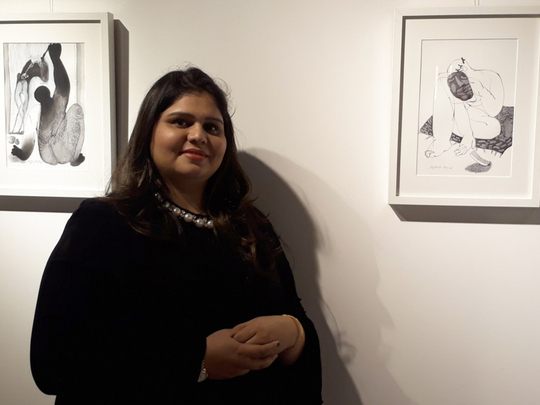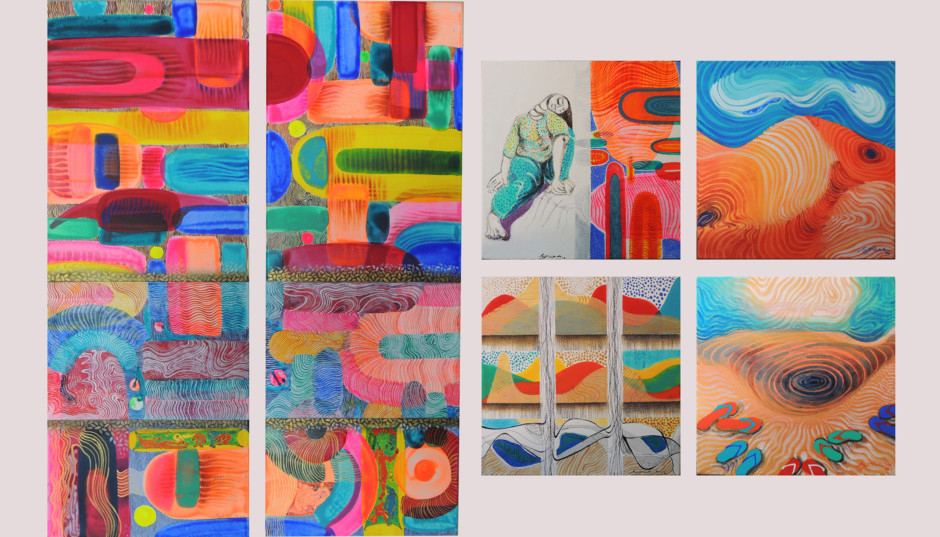
“My style is contemporary, and the main body of work and thinking is based on how the external environment affects the gestural expression and human behaviour,” says Shrutika Gosavi, a UAE-based Indian artist.
Gosavi does not cut corners when it comes to art. After completing her Masters in Visual Arts, she has been practising art full time, having won the Young Artist Scholarship offered by the Indian Ministry of Culture in 2013. As part of the scholarship, she focused on developing her work under the guidance of senior artist Aparna Anil in Bhopal, a city in the central Indian state of Madhya Pradesh.
Winning the Madhya Pradesh State Artist Award in 2016 was another achievement she could savour relatively early in her artistic career. Being born into a family where the arts were highly valued, Gosavi turned to visual art at a young age, and also trained in classical Hindustani music.
After her marriage, moving to the UAE from India and motherhood have been new experiences for her. Trying to balance her domestic duties and her art as best as she can, sometimes she has had to work late into the night on her canvases. The great family support she enjoys has been a critical factor in her success on the art front.
Gosavi says she took a two-year break in 2014 after her daughter was born and returned to painting towards the end of 2015 when she embarked on a major work titled Virat Roopa (the Universal form of God) which depicts a crucial moment from The Bhagavad Gita, a Hindu scripture in Sanskrit that is part of the epic Mahabharata. The universe, planets, earth, all things in nature are a part of Virat Roopa which is a powerful work, embodying aesthetically satisfying symmetry and economy of form.
Her commitment and hard work seemed to be paying off when she recently had two exhibitions of her paintings in Sharjah and Dubai simultaneously.
At the IRC Gallery in Sharjah, she exhibited 37 paintings and drawings comprising nine years of her work, curated by Peter Gressman, founder of artforum UAE. Titled Brush Meets Camera, the exhibition was a joint show along with talented photo artist Salma Serafi. The exhibition in Sharjah represented the very organic way Gosavi’s art has evolved.
Her work was also exhibited at Studio 7 Art Gallery in Dubai, in a group show titled The Things I Paint comprising works by four female artists from the UAE, Egypt, Pakistan and India.
Art buyers have been quick to note the quality of her works, with many of her paintings being sold. Her preferred medium is charcoal, soft pastel and ink for drawings, while in her paintings she prefers acrylic. “But as you can see, I combine both in my work. It’s a mixture of painting and drawing,” says Gosavi.
Although some academics from her college tried to discourage her, she has stuck to her style and found wide appreciation as well as buyers. “I believe if my work is strong, people will come,” she says.
“Most of my focus is on the line. You will always find forceful lines in my work. I start with lines — it is a spiritual thing — and it tends to take a life of its own. As the dialogue progresses, it directs me towards execution — with many layers of colour and lines. It’s a matter of satisfaction. Till then, you continue to work.”
She usually takes 15 to 20 days to complete an artwork but there have been complex works where she has spent up to six months on a particular painting.
One striking feature in all her figurative works is that she does not depict facial features. “The expression in my paintings comes from the gestures of the full body. And I always connect the theme with the general atmosphere. Hence for me, facial features are not that important.”
In Head: The Mask series in acrylic, ink and soft pastel on canvas, Gosavi tackles the theme of individuals and how they put on an act outside. “We carry a mask everywhere,” she says.
She does not have any particular individual in mind, but creates a powerful statement in each. And for her the process is more important than the concept, starting with random lines and ending up with multiple figures in a single painting.
The Goat series, in dry pastel and ink on paper, began life as realistic sketching exercises during her BFA and got transformed into abstract forms. Another series titled Expressions uses similar content with additional forms making its appearance.
The series Lines done during the same period is an indication of early maturing of style, elegant use of colour and form, sophisticated execution and confidence in her craft.
Although the general mood of most her work is serious, she occasionally indulges in social humour like in The Big Fat Indian Wedding — while the whole crowd of musicians and wedding guests are making merry, the bride’s face is twisted in agony. When Gosavi was very young, she liked to draw cartoons, and that streak occasionally shows up in her work, she admits.
In 2016, Gosavi took part in Liwa Art Residency at the Liwa Art Hub in Abu Dhabi, resulting in the Desert Series. Titled The Spiritual Connection Between Sea and Desert, in which she tries to find connections and contrasts in six panels — the latest urban developments on one side and the desert and sea on the other — “two extremes” that she tries to reconcile.
“When I see the desert, I get connected to the lines and I try to mimic the movement of the sand through colour, lines and shapes,” she says.
Qahar, another powerful work by Gosavi, is inspired by Picasso’s Guernica in theme and concept. It deals with the tsunami of war and depicts the screaming victims — both humans and animals. The artist, as a sensitive and empathetic soul, is also the victim of “this atmosphere of violence,” and expresses the emotions of fear and sorrow.
Mingle, a panel of five drawings, represents her latest work based on her spur of the moment impressions of urban life. It depicts different figures in a group setting. “Some of the fast sketches I do have come out eloquently, even though it is simple and there is nothing in particular I want to highlight. But at the same time, there is something going on in the background.”
Gosavi’s art is really setting out to bloom and there is a lot she can look forward to in the days ahead. Coming up next, the Ajala Group has selected six of her works for the DIFC Art Nights in March.
Those who have come across Gosavi’s work cannot but be impressed by her deep observations of life, nature, spirituality, and also bowled over by the gentle humour as well as the philosophical meditations on the human condition.
N.P. Krishna Kumar is a writer based in Dubai.














